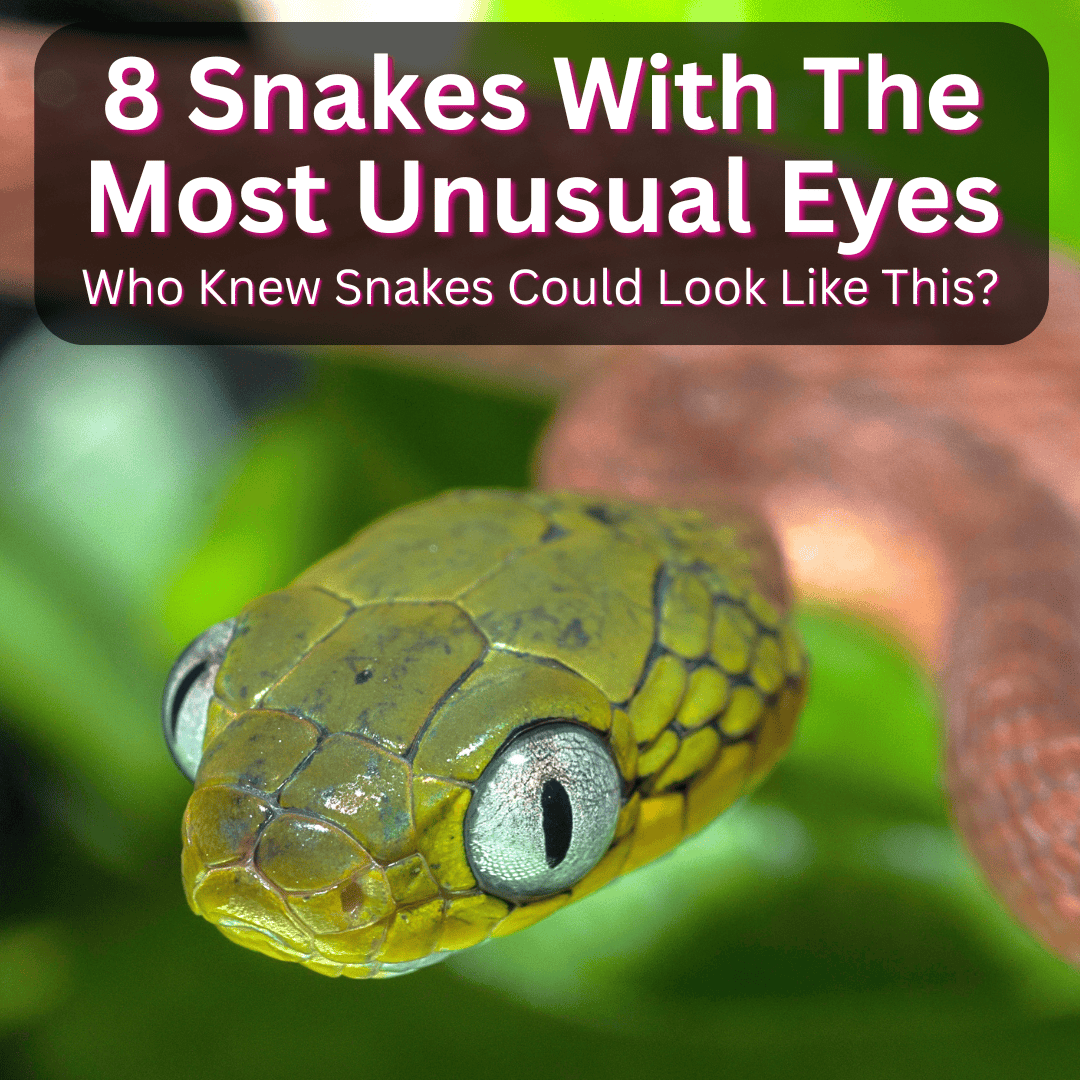
Sure, people often talk about their slithery moves or wild patterns.
But you know what?
Snake eyes are where nature gets really weird and wonderful.
Get ready to meet snakes with eyes so unusual, you might think they’re from another planet.
These reptiles have evolved eye features that help them survive in their own wild ways.
Snakes With The Most Unusual Eyes
Some of the following snakes have huge eyes for hunting, others sport wild colors or shapes that make them instantly memorable. You’ll see snakes from all over the globe, each showing off nature’s creativity with their stunning, sometimes downright bizarre, eye designs.
1. Vine Snake
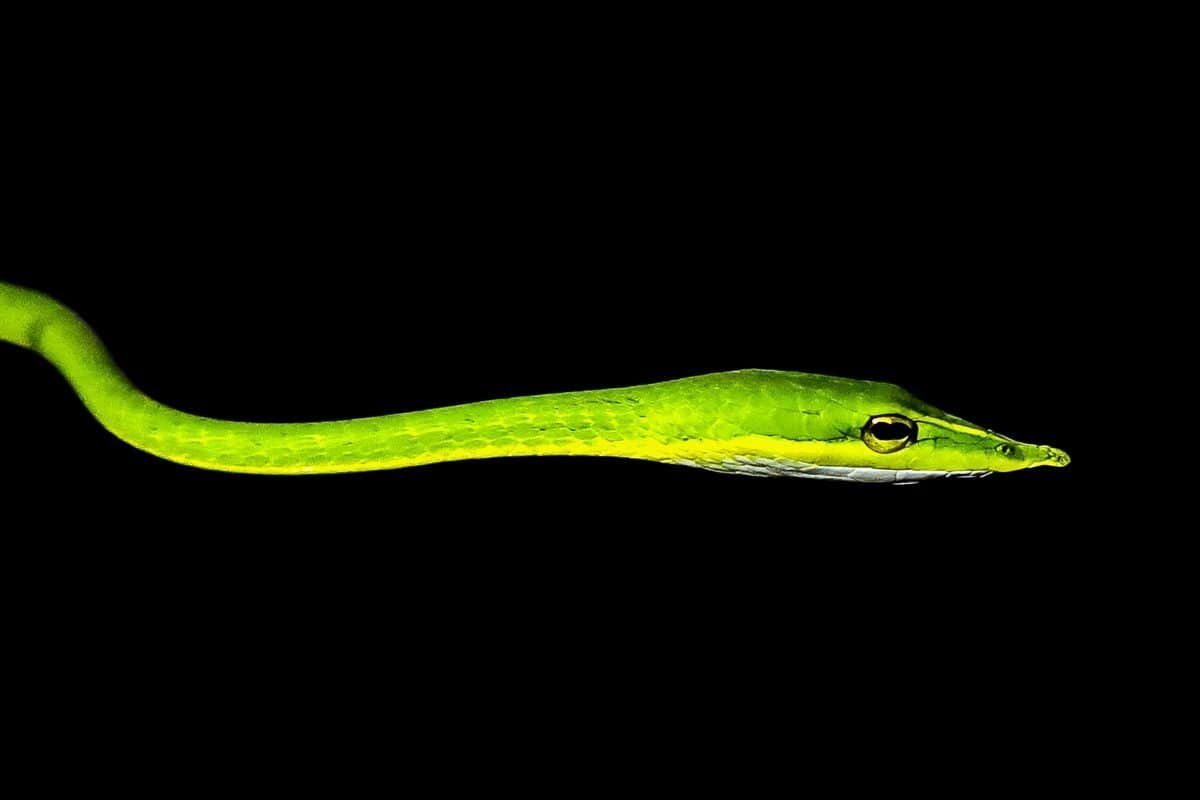
Just take a look at a vine snake and you’ll see what I mean—its eyes are seriously something else. They’ve got these long, horizontal pupils that look like keyholes or slim slits, almost like little windows into another world.
Those weird pupils help the snake blend in perfectly with leaves and branches. Its face almost disappears into the greenery, looking more plant than predator.
Unlike most snakes, vine snakes have their eyes facing forward instead of on the sides. That gives them better depth perception for hunting in the trees—pretty handy if you ask me.
The eyes and the snake’s skinny green body work together so well. Spotting one in the wild? Good luck—it looks just like a vine dangling from a branch.
The horizontal pupils let in just enough light for hunting lizards and birds in dappled forests. And when it comes to hiding, those camouflaged eyes are a lifesaver. Predators barely stand a chance at spotting them when they’re chilling in the trees.
2. Big-Eyed Tree Snake Of Madagascar
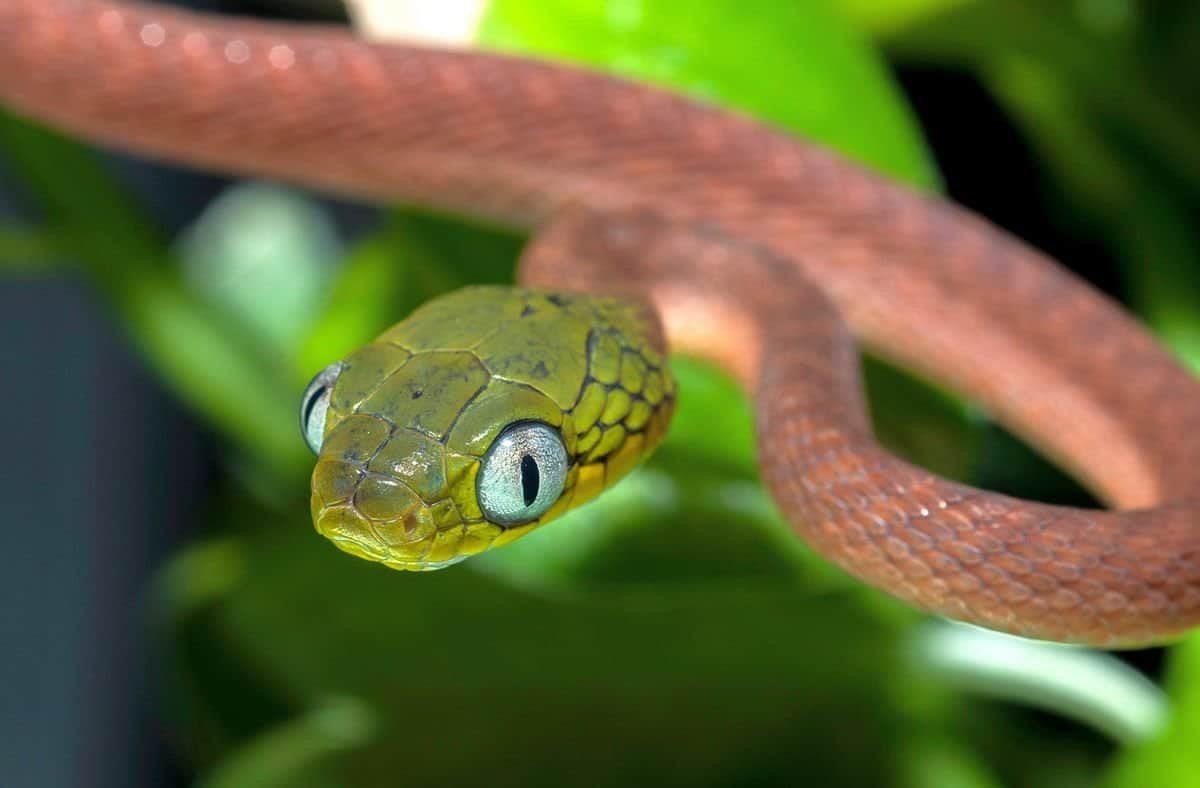
This snake only lives in Madagascar, and its eyes are huge—almost comically big, like it’s always surprised. They look straight through you, honestly.
With a slim, bendy body, it moves through branches like it owns the place. Its golden color just adds to the drama.
People call it the Common Big-Eyed Snake, but scientists know it as Mimophis mahfalensis. You’ll find it in the dry parts of central and southern Madagascar, hunting both on the ground and up in the trees.
No need to panic if you spot one—they’re harmless and really only bite if you make them feel trapped. Usually, they’d rather just slither away and avoid any fuss.
If you’re patient, you might see one trying to outsmart a lizard, darting and weaving as the lizard dodges just out of reach. Madagascar is packed with animals you won’t find anywhere else, and this big-eyed snake is one of its coolest residents.
3. Eastern Diamondback Rattlesnake
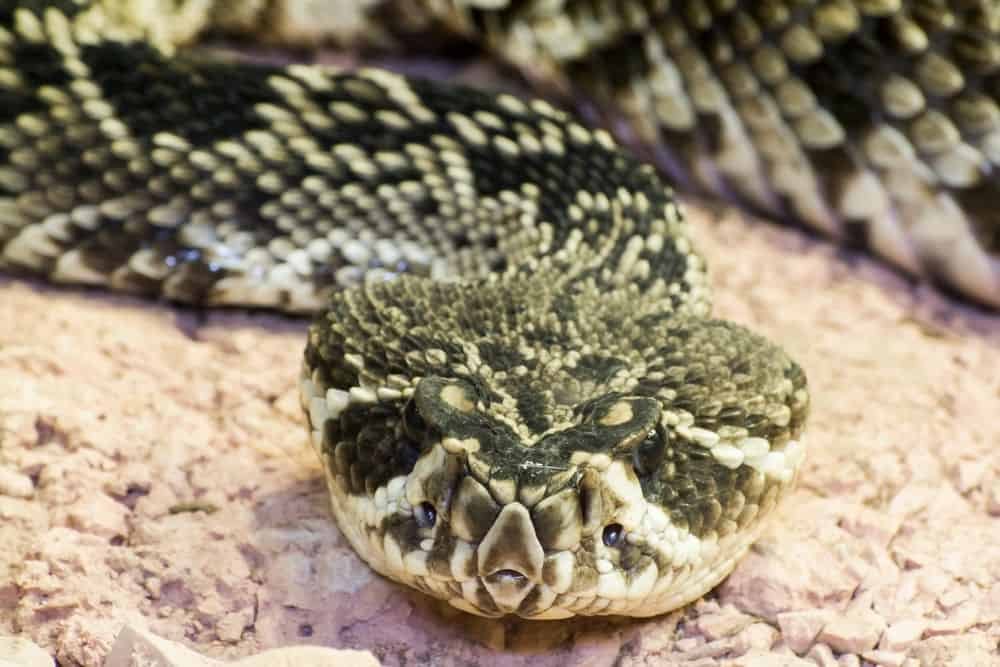
The Eastern Diamondback Rattlesnake has some of the wildest eyes out there—dark, beady, and kind of intimidating if you stare back for too long.
Its vertical slit pupils look both beautiful and a little scary, surrounded by darker coloring that makes them stand out even more.
You’ll spot a dark stripe running diagonally through each eye, outlined in white and stretching down toward the neck. Between the eyes and nostrils, there’s a heat-sensing pit—think of it as built-in night vision for tracking warm-blooded prey.
Those eyes double as movement detectors. With their spot on the snake’s broad head, they’re always ready to catch any sudden motion.
When you look into those bead-like eyes with their dramatic slits, you’re seeing a design built for hunting—sharp, striking, and totally unique.
4. Big-Eyed Rat Snake Of Taiwan
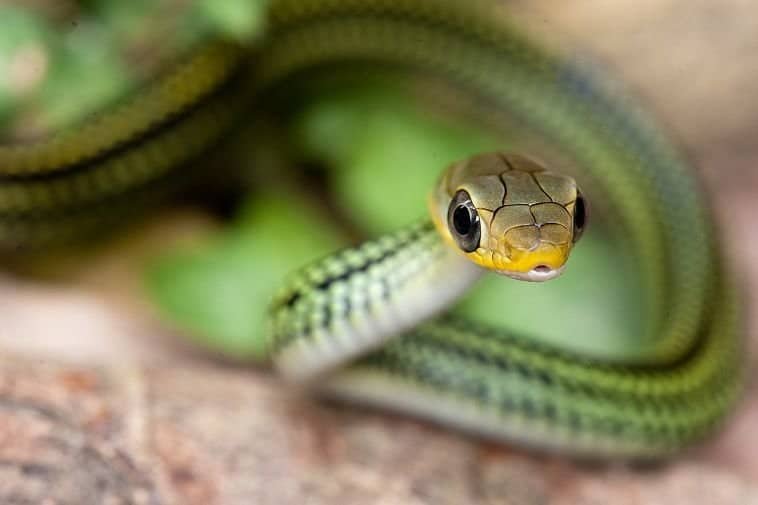
The big-eyed ratsnake calls Taiwan and parts of Asia home, and it’s earned the title of Asia’s fastest snake. Its huge eyes are so expressive, sometimes it almost looks like it’s reacting to you with surprise.
Run into one and you’ll see what I mean—it can vanish into the undergrowth in a blink if it feels threatened. It can reach lengths of up to 2 meters long, but is extremely thin. That thin body just makes those eyes look even bigger.
No worries about venom here; these snakes are harmless to people. They do get jumpy, though, and their twitchy movements plus those big eyes can be a little startling if you’re not expecting it.
The combo of speed and those massive eyes helps them hunt and escape danger. Honestly, you’re lucky if you get more than a glimpse—they move through the forest like ghosts.
5. Madagascar Leaf-Nosed Snake
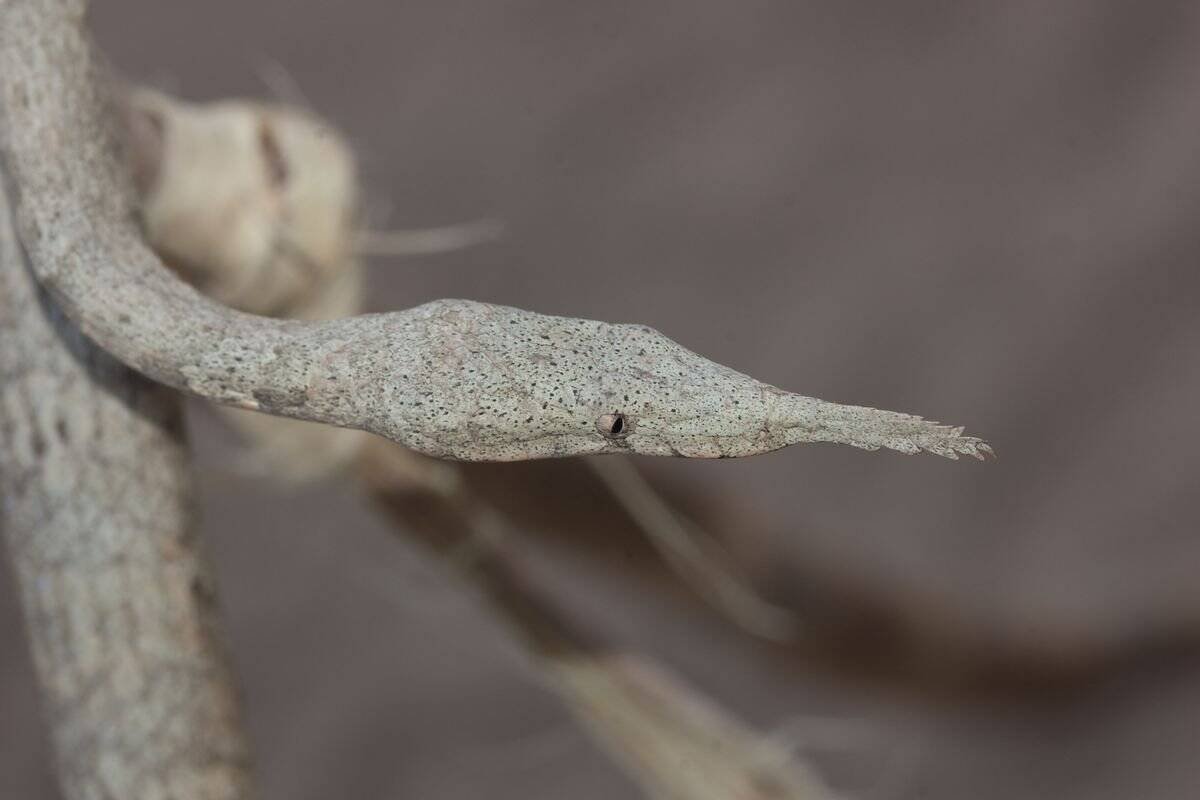
The Madagascar leaf-nosed snake has some of the coolest eyes in the snake world—big, prominent, and perfect for night hunting.
Its eyes sit just right for seeing among the branches, totally different from ground-dwelling snakes. That placement lets them judge distances as they move through the trees, which is pretty important when you’re living up high.
Their pupils adjust fast to changing light, so they can see both day and night. Pair that with their wild, leaf-shaped nose and you’ve got a snake built for life in Madagascar’s forests.
They use those sharp eyes to spot lizards and frogs, even when the prey is quick. The eye structure also helps them stay hidden—they can spot danger while barely moving a muscle among the leaves.
6. Banded Cat-Eyed Snake
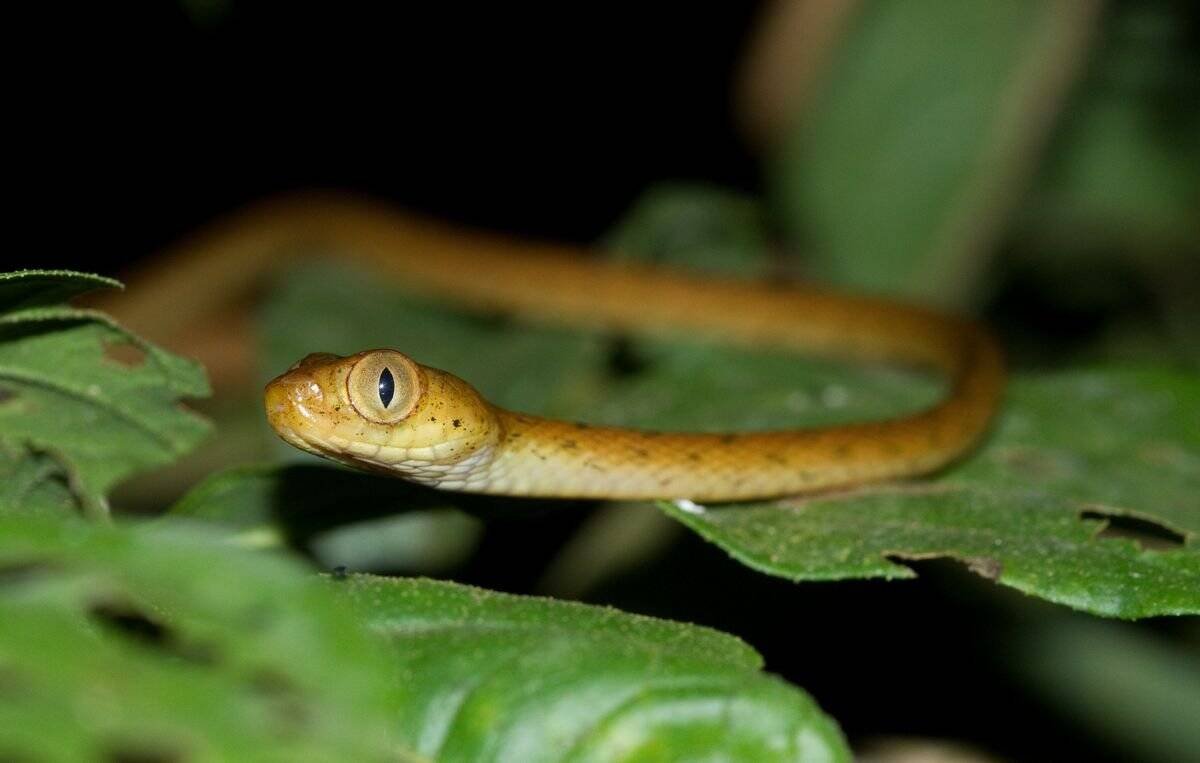
The banded cat-eyed snake is named for its most captivating feature—its large, gleaming eyes that look uncannily like those of a cat. Peer into its face at night and you’ll see those eyes shining with a golden or coppery glow, each one marked by a vertical, elliptical pupil that seems to slice right through the darkness.
These pupils aren’t just for show. They’re built for night hunting, opening wide after sunset to let in every scrap of light, giving the snake a powerful edge as it prowls for frogs and lizards.
Its eyes stand out even more against a body banded with yellow, brown, or olive scales and dark spots, creating a look that’s both striking and perfectly adapted for blending in with the dappled shadows of its forest home.
The banded cat-eyed snake’s gaze is alert and curious, always scanning its surroundings for movement, and its vision is so sharp that it can spot the faintest twitch of a potential meal.
Like its feline namesake, this snake is mostly nocturnal, relying on its specialized eyes to navigate and hunt in near-total darkness. It’s a master of the night, and those signature cat-like eyes are the secret to its success, making the banded cat-eyed snake one of the most fascinating and visually unforgettable snakes in the Americas.
7. Eyelash Viper
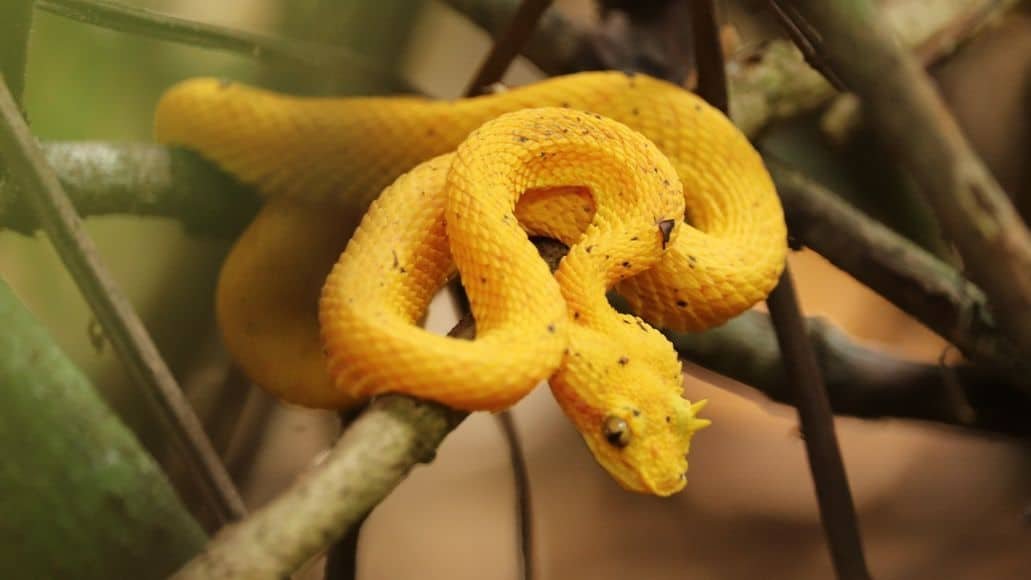
If there’s a snake that looks ready for a close-up, it’s the eyelash viper. Its eyes are already striking on their own: round, bright, and often shimmering with gold, green, or copper hues. But what really steals the show are the quirky, scale “eyelashes” that arch above each eye.
These fringed scales aren’t just for flair; they help break up the snake’s outline among flowers and leaves, making it a master of camouflage in the rainforest.
The eyelash viper’s pupils are vertical slits, perfect for adjusting to the shifting light beneath the jungle canopy. During the day, those pupils narrow to razor-thin lines, but at night, they widen to let in every bit of moonlight, helping the viper track frogs, birds, and small mammals that wander too close.
Get close enough (not that you’d want to), and you’ll see the viper’s eyes catch the light, flashing with a hypnotic intensity that’s both beautiful and a little intimidating.
The colors often match the rest of the snake’s body—anything from electric yellow to mossy green or even pink—making the eyes look like tiny, living jewels set among its scales.
With its signature lashes and vivid gaze, the eyelash viper is proof that nature loves a little drama. Its eyes don’t just help it hunt. They make it one of the rainforest’s most unforgettable residents.
8. Bush Viper
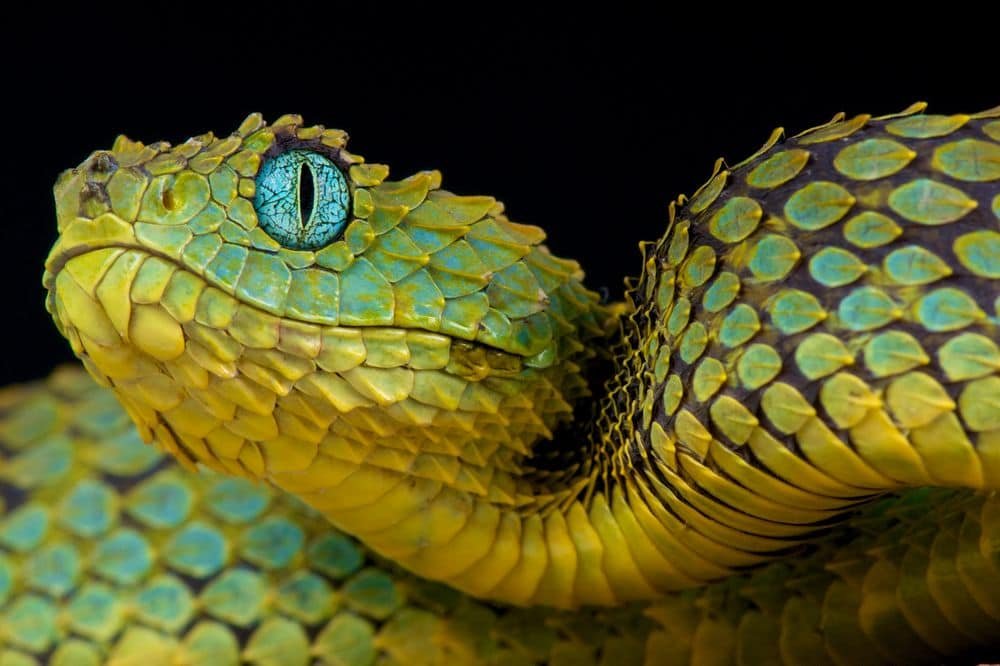
The bush viper is a showstopper—its eyes are every bit as wild as its vibrant, textured scales. Peer into a bush viper’s face and you’ll notice eyes that seem to glow, usually a brilliant yellow, orange, or deep gold, often echoing the colors found on its body. The effect is mesmerizing, like staring into a gemstone set in living armor.
What really sets the bush viper’s eyes apart are their vertical, cat-like pupils. These slits can expand wide at night, letting in just enough light for the viper to hunt after dark—perfect for an ambush predator that likes to wait quietly among the branches.
During the day, the pupils shrink to fine lines, protecting the sensitive eyes from harsh sunlight and sharpening their focus on anything that moves.
The scales around the eyes are raised and ridged, almost like natural eye shadow, making the viper’s stare even more dramatic. This not only gives the bush viper a fierce, almost mythical look, but also helps break up its outline in the dappled forest light, keeping it hidden from both prey and predators.
If you ever spot a bush viper, it’s the eyes that will stick with you. They’re alive with color, intensity, and a sense of quiet patience—waiting for the perfect moment to strike. In the world of snakes, few eyes are as unforgettable as those of the bush viper.
Why Snake Eyes Are So Unique
Snake eyes have evolved features that set them apart from most animals. Their pupils come in all sorts of shapes, each helping them hunt or survive in their own way.
The Evolution of Snake Eyes
Over millions of years, snake eyes changed to fit their hunting styles. Most snakes lost their eyelids along the way, which means they can’t blink like we do.
Instead, a clear scale (called a spectacle) covers their eyes, protecting them while still letting them see.
Different species developed different eye features depending on where they live. Tree snakes ended up with big eyes for spotting movement in the branches, while ground snakes often have smaller ones since they rely more on smell and heat.
Day-active snakes usually have round pupils, like ours. Night-active snakes tend to have vertical pupils that work better in the dark.
Some snakes even developed heat-sensing pits near their eyes, letting them “see” the warmth of prey in total darkness.
Functions Of Different Pupil Shapes
The shape of a snake’s pupil says a lot about how it lives and hunts.
- Round pupils work best in bright daylight. Snakes with round pupils usually hunt when the sun’s up and there’s plenty of light. These pupils let in a steady amount of light—nothing fancy, just reliable vision for the day shift.
- Vertical pupils show up in a lot of night-hunting snakes. These can open wide in the dark to grab more light, then shrink to slits if things get too bright. It’s a handy trick for creatures that never know when the light will change.
- Horizontal pupils are honestly pretty rare in snakes. But when you do see them, they’re great for spotting movement across the ground. This shape gives a wider field of view, which helps with tracking prey that likes to scurry.
Tree snakes often have big eyes and large pupils, which help them catch even the slightest movement in leaves and branches. On the flip side, snakes that hunt by smell or heat can get by with much smaller eyes. Not every snake needs perfect vision.
How Unusual Eyes Help Snakes Survive
Snake eyes come with a bunch of special features that help them hunt and stay out of trouble. Their vision gives them an edge.
The vine snake, for example, has oversized eyes that pick up the tiniest twitch in tree branches. That sharp eyesight means it can catch small lizards and birds that other snakes might never notice.
Some species have eyes that stick out a bit from their heads. That way, they can stay hidden but still peek out to watch for prey or danger. Not a bad strategy.
Heat-sensing abilities near the eyes let certain snakes find warm-blooded prey—even if it’s hiding. They can pick up temperature differences as tiny as 0.1 degrees Fahrenheit. That’s wild.
The big-eyed tree snake from Madagascar uses its golden eyes for nighttime hunting. Those eyes help it weave through dark forest branches, catching things most of us would never see.
Plenty of snakes can see ultraviolet light, which is invisible to humans. This helps them track down prey that might slip past other hunters. Nature’s got some clever tricks up its sleeve.
Fascinating Adaptations Beyond Snake Eyes
Snake eyes are just one piece of their survival puzzle. Many snakes use heat sensors to hunt warm-blooded prey in total darkness, while others have eye colors that help them disappear into their surroundings. It’s honestly a little mind-blowing sometimes.
Infrared Vision And Heat Sensing
Did you know some snakes can “see” heat? Pit vipers, pythons, and boas have these special pit organs that work almost like thermal cameras.
The pit organs sit between the eyes and nostrils, picking up temperature shifts as tiny as 0.003 degrees Celsius. So yeah, a snake can find a mouse in pitch black just by sensing its body heat. Pretty incredible.
Snakes with heat-sensing abilities:
- Rattlesnakes
- Copperheads
- Ball pythons
- Boa constrictors
Watch these snakes hunt and you’ll notice them moving their heads back and forth, almost like they’re sweeping a flashlight. They’re scanning for heat, sending the info straight to their brains to build a heat map of what’s around.
Camouflage And Eye Coloration
Spotting a snake? That often depends on how well its eyes blend in. Their eye colors aren’t just for show—they’re survival gear.
Green tree snakes usually sport bright green or yellow eyes, blending right in with leaves and sunlight. Desert snakes? They go for brown or amber, matching the sand and rocks around them.
Some snakes have iris patterns that break up the round look of their eyes, making it tougher for both predators and prey to spot them. These patterns can mimic bark, leaves, or even rocks. Nature’s camouflage game is strong.
Common eye colors and their purposes:
- Green/Yellow: Tree-dwelling species
- Brown/Amber: Ground and desert dwellers
- Red/Orange: Night hunters
- Black: Burrowing species
Pupil shape matters too. Vertical pupils help snakes hide in tall grass or tree branches, while round pupils suit those living in open areas. It’s all about fitting in—or standing out—when it matters most.
Unusual Snake Eyes: Conclusion
Snake eyes come in all sorts of shapes and sizes. Different species have developed some pretty wild eyes to fit their own needs—sometimes you look at them and just think, wow, that’s not what I expected from a snake.
Big eyes let snakes see better when it’s getting dark out. Thin pupils help them lock onto prey with surprising accuracy.
Some snakes have eyes that almost look alien, honestly. Others show off colors that make you stop and stare, even if you’re not a snake fan.
But these eye features aren’t just there for show. They help snakes:
- Hunt down food
- Hide when danger’s close
- Navigate their territory
- Survive in all sorts of environments
Tree snakes usually have big eyes for spotting prey among the leaves. On the other hand, ground snakes might have smaller eyes since they tend to rely more on their sense of smell than sight.
If you ever get a chance to look closely at a snake, check out its eyes. There’s a good chance you’ll notice something you didn’t expect.
Every snake species seems to have eyes that just work for their lifestyle. Nature’s kind of clever like that—it gives them what they need to get by. Whether it’s the vine snake blending in with leafy greens or the cat-eyed snake seeing in the dark, these reptiles really show off how varied life can be.
Snake eyes are a reminder that there’s always something new to notice in the natural world. Even the tiniest details can be pretty fascinating if you stop to look.
Leave a Reply